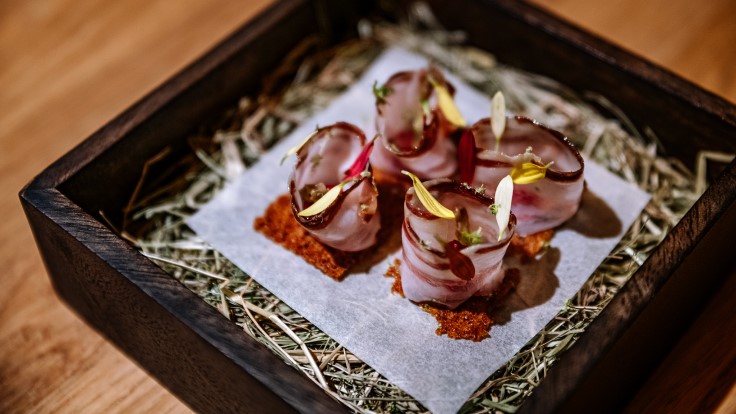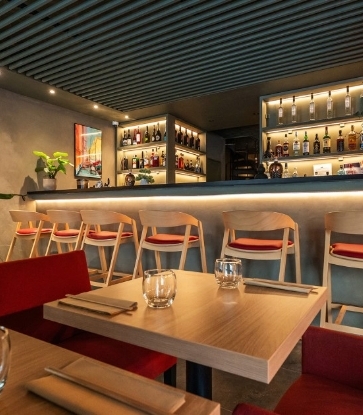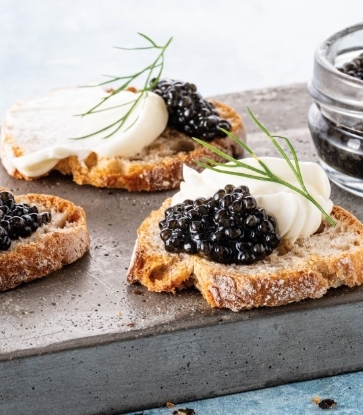Mangalitsa (also known as Mangalica or Mangalitza) pork is one of Hungary’s national culinary treasures, and is cherished by Hungarian chefs, as well as chefs and food-lovers around the world. A particular breed of Hungarian domestic pig is to thank for Mangalitsa pork, a high-quality meat characterised by its distinctive fattiness and exemplary flavour that can be prepared in a number of ways including grilling, roasting, braising and ageing. Here, we find out more about this much-revered Hungarian delicacy and the creative ways in which the country’s chefs are using it in their dishes.
Nose to Tail Cooking

“Mangalitsa pork is a special type of pork that holds great importance in Hungarian cuisine,” explains chef Ádám Thür of IKON in Debrecen – who works closely with the Hungarian Mangalitsa Association to source Mangalitsa pork from reputable breeders who prioritise animal welfare and sustainable farming practices. “It’s derived from the Mangalitsa pig, a breed known for its distinctive appearance and exceptional meat quality. Mangalitsa pigs have a unique woolly coat, similar to that of a sheep, which sets them apart from other pig breeds.”
According to Ádám, the remarkable flavour and texture profile of Mangalitsa pork is key to why it’s held in such high esteem by the food industry. “The meat is highly marbled with intramuscular fat, resulting in a rich and succulent meat. This marbling also retains moisture while cooking, which creates an incredibly tender and juicy texture. The high fat content also contributes to the pork's exceptional flavour, which is another reason why it’s highly sought after by chefs and food-lovers alike.”
At IKON, Ádám and the team use the Mangalitsa from nose to tail. “We make a jus from the trotters and a terrine from the hocks, nose and tail,” he says. “The tenderloin is served in a traditional dish with peas and marjoram; the loin is always on our menu and is cooked in a seasonal garnish or fried in breadcrumbs; and we also have world famous ‘debreziner’ sausages on our blackboard, served with local horseradish and fresh bread.”
Mangalitsa pork’s importance in Hungarian cuisine stems from the meat’s “deep-rooted history and the cultural significance of pork in Hungarian culinary traditions”, Ádám explains. “Whether used in traditional Hungarian dishes or incorporated into innovative and modern creations, Mangalitsa pork is cherished for its unparalleled taste and quality. Nor is it limited to Hungarian cuisine alone; its reputation has spread globally and it is celebrated by chefs and food enthusiasts around the world. Its unique characteristics and exceptional taste make it a prized ingredient in various culinary traditions, including Spanish ham making.”
Premium Product

“Mangalitsa pork has gained significant attention and popularity among farmers, chefs and food enthusiasts in recent years,” agrees chef Jenő Rácz of Budapest’s Rumour. “It can be seen as being the Hungarian equivalent of Wagyu steak. As well as being a part of Hungarian tradition, it’s a premium product that we’re very proud of.’”
For Jenő, it’s the quality of the Mangalitsa that really sets it apart. “It’s highly marbled, rich in flavour, and has a unique taste that sets it apart from conventional pork,” he explains. “The meat is succulent, tender and offers a melt-in-your-mouth experience. As well as the meat itself, Mangalitsa pigs are also valued for their high-quality fat. The lard derived from Mangalitsa pigs has a distinct, rich flavour that adds depth to culinary creations.”
At Rumour, this celebrated meat is served as a confit Mangalitsa pork loin in a caramelised onion crust with peanuts, petits pois à la française and confit baby carrots. The Mangalitsa is sourced from free-range pigs in Hungary’s Tokaj region, which is also world-famous for its wine.
Refined Flavour

One of the reasons Mangalitsa pork is so revered in Hungary – and beyond – is that it’s the only porcine species native to Hungary. “Mangalitsa is a breed that has its origins in the crossing of the primitive Sumadija race (of the Mediterranean branch, to which the Iberian pig also belongs) with the Szalonta and Bakony races (typical semi-wild breeds from the Carpathians),” explains chef Csaba Puskás of Budapest’s Borkonyha Winekitchen.
In addition to the pig’s visual appearance, its taste also sets it apart from other types of pork. “The taste of Mangalitsa is much more refined,” Csaba continues. “The Mangalitsa fat delicately infiltrates the flesh and gives it a beautiful, delicious mottling. The breed’s fatty meat also makes it ideal for the production of cured ham, as it’s particularly suitable for drying and prolonged maturation. Not only that, but its carcass has half the meat and twice as much fat as a white pig.”
Mangalitsa makes an appearance on every menu at Borkonyha. “Mangalitsa plays a very important role at our restaurant. On our current menu, it’s served as a ragout with Mangalitsa cheek (which is confited in its own sauce at a low temperature) and ear (which is poached), served with morel mushrooms, pickled radishes and sturgeon caviar.”
In spite of its popularity, Mangalitsa is nevertheless still an artisan product, according to Csaba. “The pig can never be bred in large quantities due to the specific ways it is reared and fed,” he says. “As a result, the price is higher than that of other pigs.”
Best Pork in the World

“Mangalitsa is a very nice meat to work with,” offers chef Szilárd Tóth at Budapest’s Salt. “Its taste falls somewhere between plain domestic pork and wild boar, which makes it very exciting and distinctive to eat and cook with. It’s the best pork in the world – its meat-to-fat ratio, texture and taste are perfect.”
When working with Mangalitsa, sourcing top-quality meat from free-range pigs is essential. “The meat we use comes from Olmos and Tóth Kft., a producer belonging to the Hungarian Mangalitsa Association. We then source the dry cured meats from my family’s business, Szatmár Dry Cured. It’s located in Nyírmeggyes and features a traditional adobe house where they produce dry cured coppa, guanciale and pancetta.”
With their premium quality meat, Szilárd and the team at Salt work with Mangalitsa in innovative and exciting ways. “At Salt, we’re currently using dry-cured Mangalitsa pancetta in our signature 'greasy bread' dish, and we have a main dish with Mangalitsa spare ribs and a Mangalitsa garum [a type of fermented fish sauce].”
Chef’s Honour

“It’s an honour for a chef to use Mangalitsa, so they need to be careful in how they prepare it to bring out the best of the meat,” suggests András Pető of Budapest’s Stand25 Bisztró, which sources high-quality Mangalitsa from the Alföld area of Hungary. “It’s part of our country’s heritage, and an ingredient that’s extremely important to us.”
“Mangalitsa is surprisingly versatile,” he adds. “It has a much deeper and more complex flavour than other varieties of pork. The meat is more marbled than other varieties, and juicier, which means preparing it can be slightly more difficult.”
At Stand25 Bisztró, Mangalitsa cutlet is used to make the restaurant’s traditional cordon bleu, served with ham and cheese. “We also use the shoulder blade to make our meatloaf. This is a very traditional dish that we always pair with something seasonal such as butternut squash stew in the early summer or yellow peas, green beans or green peas.”
Hero Image: Salt
Best Pork in the World Image: Credit Dávid Horpáczi


















